Do you ever dream about creating your own needlepoint designs? I get lots of questions related to that topic, so this week, we’re going to take a peek at some of the things you need to know about getting started with painting needlepoint canvases. Sound good? Alrighty, then let’s dive in!
Before you don your artist’s smock, we should take a look at the tools and materials you’ll need for painting needlepoint canvases.
Without a doubt, the most common question I get about painting needlepoint canvases is “What kind of paint should I use?”.
I use Liquitex soft body acrylic paint. You can order it directly from the Liquitex website here. You may find it in local art supply shops, too. An equally good paint is Golden fluid acrylic paint. Both Liquitex and Golden paints are artist quality products. You should be able to use them straight out of the bottle.

Beware of craft acrylic paints, such as Delta Ceramcoat and FolkArt. They are of a lesser quality and it’s best to avoid them when painting needlepoint canvases. They don’t provide good coverage and they are chock full of fillers which means they have less pure pigment (color). They can have a tendency to fade over time, too – and darker colors sometimes become milky.
You’ll also need paint brushes to paint your designs onto needlepoint canvas.

My best advice is to use inexpensive brushes because you’ll wear them out quickly. Acrylic paint is hard on natural bristle brushes, so I recommend using synthetic sable bristle brushes.
There are two primary kinds of brushes you’ll find yourself using over and over again: round bristle brushes (sizes 3/0, 2/0, and 0) and bright bristle brushes (sizes 6 and 8). Round bristle brushes are exactly what they sound like – they’re round. Bright bristle brushes have a flat, squared off end with short bristles. Use the bright bristle brushes to fill in larger areas of color and use the round bristle brushes for finer details.
Acrylic paint cleans up with soap and water. Be sure to clean your brushes thoroughly after each use.
An alcohol based thinning agent is the best option for thinning acrylic paint.
Paint for painting needlepoint canvases should be the consistency of half-and-half/light cream. (If you don’t drink coffee or like to cook, think liquid foundation make-up. ;)) If your paints become too thick, you’ll need to thin them with an alcohol based thinning agent. Liquitex and Golden both have specially formulated products that work well to help their paints retain its opacity.
In a pinch, you may use water to thin acrylic paint, but it will become more translucent and you will need to apply more coats to get smooth coverage.
When painting needlepoint canvases, you’re bound to make mistakes – or have paint drips – every now and again.
So how do you “erase” those boo-boos?
Gesso to the rescue!

Gesso is an opaque artist’s medium. It is commonly used as a primer – or base coat – before applying paint to canvas. It comes in white, cream, and black, but I use white the most often. It works very much like “White Out” liquid paper. (And speaking of White Out… do NOT use it on your needlepoint canvases. Not only does it become discolored over time, but it will eventually flake off.)
Thin the Gesso with water until it is the consistency of half-and-half cream, then paint it onto the canvas where you want to change – or delete – a color. Allow each coat to dry before applying another one. It will take multiple coats of Gesso to cover darker colors.
If you have an accidental splatter or drip, grab some rubbing alcohol and work quickly with a clean soft rag. You should be able to get most of the paint off the canvas.
And last, but not least, you’ll need blank needlepoint canvas.
My preference is Zweigart mono canvas. That’s the kind of canvas most needlepoint designers use – and it’s what you’ll find in your local needlepoint shop. Zweigart canvas features an orange thread in the selvedge. Here’s a picture for you…

Make sure that you paint the design onto the canvas so that the selvedge edge is on either the right or the left side. Needlepoint canvas, just like any other fabric, has a grain and you want to stitch with it – not against it. 😉
Use a waterproof pen to transfer your design to the canvas.
Sakura Pigma Micron pens are my all-time favorites. I’ve never had a problem with them bleeding or smearing, unlike other pens that claim to be permanent.
I use sizes 005 and 01 to draw directly onto the canvas. (Remember to use a light touch when transferring design lines. You don’t want heavy black lines that will be hard to cover.)
I recommend size 05 for drawing your original design. The nib is thick enough to create lines that you can easily see through the canvas mesh.
Alrighty, my friend… that brings us to the end of this overview of what you need to get started painting your own needlepoint canvases.
Thank you ever so much for dropping by. Until next time, happy stitching! 🙂
XOXO!!








Quick question – regarding the paint brands that you mentioned that you don’t recommend, besides the color issues, are they okay to use just to cover/darken a whole canvas for a monochromatic bargello project? Do they bleed, run when wet or flake off?
Also, another burning question – put beads on before or after blocking?
Thanks for your expertise!
Jane
Hi Jane!
You have some great questions. I can’t speak to whether or not the FolkArt and Ceramcoat will flake, bleed, or run when wet. I’ve never tested those things to see how they respond. You could definitely do a trial run on some scrap canvas, if you’re concerned about any of those things happening, though. As far as using them to color the canvas for a monochromatic bargello project, if you plan to cover the entire canvas (no canvas peeking through) with your stitching, I supposed they could work. Again, I offer no guarantee that they would provide you with a desirable end result.
And to answer your question about beads, it depends up on your blocking method. I attach them before blocking. I secure the canvas to a blocking board and I mist the canvas with a spray bottle until it is damp. (Of course, I’ve tested the the threads I used to stitch the project to ensure that they are colorfast when using that method.) If you plan to use a steam iron and a pressing cloth to block your stitched canvas, I would wait to attach the beads after you’ve blocked your piece.
Hope this helps – and happy stitching!
XOXO!
Ellen
Hope this helps.
I understand you must use a base coat on the canvas to prepare it for the color you wish to use. What do you suggest for this?
Hi Pat
You have a couple of options. Plain white Gesso will work for white mono canvas. Just water it down a little bit and use a larger brush to “wash” over the surface of the canvas, then let it dry completely. If you’re planning to create canvases to sell, you might look into colored Gesso.
Hope this helps…
XOXO!
Ellen
Very valuable information as usual.
Great job!
Thank you so much, Debbie! I’m so glad you found it helpful. 🙂
XOXO!
Ellen
Great article Ellen!! You are always so helpful, thank you 😊
Thank you for your kind words, Beverly. It’s my pleasure. 🙂
XOXO!
Ellen
Thank you for the information. I love to do my own canvas but I have never painted one. I would love to see more blogs in this subject.
Hi Bonnie!
Thank you for taking the time to share your thoughts with me. You can expect more info about this subject to come your way soon. It’s quite a popular topic. 😉
Have a terrific rest of your day.
XOXO!
Ellen
Super information…thanks
So glad you liked it, Susan!
XOXO!
Ellen
Thank you for a very informative blog posting.
You’re very welcome, Nancy! I’m glad you enjoyed it and found it helpful.
Have a terrific Tuesday!!
XOXO!
Ellen
Thank you so much, Ellen!!! When I messaged you on this subject, I was set on use a marker. I have ‘come around’ to acrylic paint and this post was so helpful. Fingers crossed that I get this right, the information you’ve given is terrific! Love this group and really appreciate how much you and your team have helped me with my needlepoint!!!!!
Hi Celeste!
Thank you so much for your sweet note. I’m glad I was able to help. We’re delighted to have you as part of our Serendipity family!! Good luck with your project… and happy stitching!
XOXO!
Ellen
How do you transfer a picture to the canvas?
That’s a terrific question, Wendi, and worthy of a new blog post. I’ll definitely add it to the list of topics coming up this summer, so keep an eye out for it. 😉
Happy stitching…
XOXO!
Ellen
Hi Ellen. Your information is always so helpful. My question is could waterproof fabric markers be used instead of paint to color a canvas? I am doing a bargello stitch and the white canvas shows through a little. Thanks so much.
Hi Melissa
I’m so glad I’ve been able to help you on your adventure in stitches. 😉
You have a terrific question about coloring canvas. The only markers I would recommend are Copic markers. You can get them at Hobby Lobby – and, most likely, the other big box craft chains, too.
Have a wonderful rest of your day and happy stitching!!
XOXO!
Ellen
Im a little confused .. why would you recommend using the Micron pen to transfer a design to a canvas if you’ve already painted a design using the acrylic paint. Did I misread your article?
Hi Sandra
I’m happy to help. The black micron pen is used to transfer or draw the outlines of the design components on the canvas. Then, you go back and fill in the areas with the paint.
I hope this helps… and if you have any other questions, just let me know. Thank you for stopping by for a visit.
Happy stitching…
Ellen 🙂